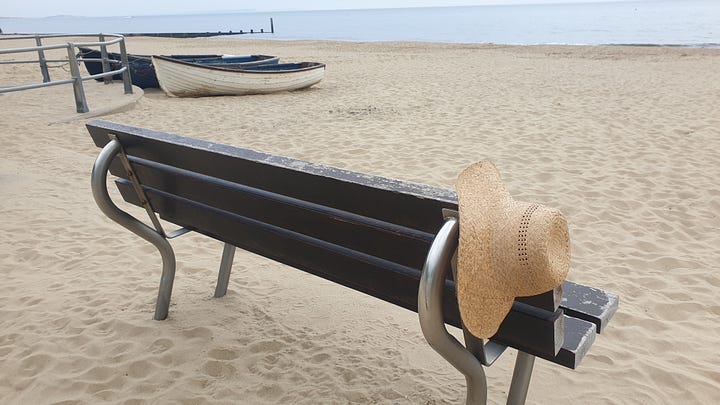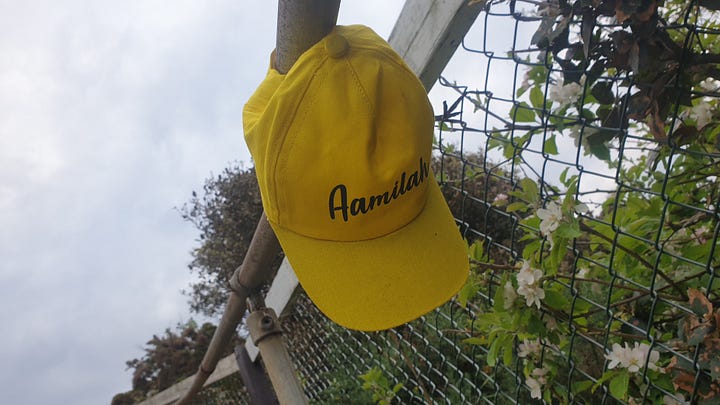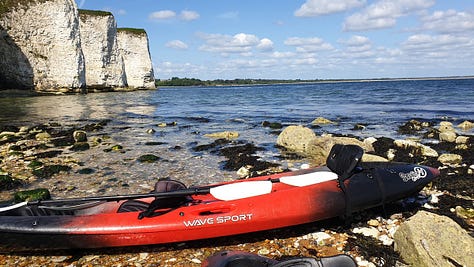The Secret Society Of Lost Hats
One of the day’s less interesting roadside flotsam compared to the drifts of cotton fruit and the odd tortoise
Happy Friday!
And greetings from the Gipsy Palace, with hyacinths in my nostrils.
I’m up in London again for another Friday night on the town because sometimes it’s better to — and here’s one of my favourite new phrases — prescribe the symptom.
No time to get everything done? Slow down and take the night off. And keep an eye out for lost hats.


A friend once blew my mind with his story about a friend from the States who’d spent twenty-plus years picking up lost playing cards — you know, the ones you see littering the streets? Keep an eye out, you’ll see ‘em — until he completed a whole deck.
Fifty-two unique cards, plus jokers. If that doesn’t blow your mind, then start looking.
Last summer, another friend and I were on a bike ride — actually, the last 125km of Thighs of Steel — and we spotted a blue baseball cap on the side of the road.
I didn’t think anything of it: one of the day’s less interesting roadside flotsam compared to the drifts of cotton fruit and the odd tortoise.
But my friend pulled sharp to a stop, picked the battered cap up and brushed it down.
‘I love these weird old caps,’ he said, showing off his find. ‘Look at that — !’
I looked. The word ‘Castrol’ was stitched into the forehead.
For the rest of the ride, the game was cap-spotting. We found no fewer than six caps that day.
Fast forward to a couple of weekends ago, instructing in the Chiltern Hills. One of those deceptive spring days where the sunrays were stronger than the ambient temperature.
I was surprised to get home and feel the heat still radiating off my scalp.
‘I need a cap,’ I said to myself, without really knowing what I was letting myself in for.
Since then, I’ve been on the look out, hoping to join the secret society of lost hats. So far, I’ve only come up with a luscious woven beach hat and a child’s baseball cap.
Anyway. If you know a kid called Aamilah, let her know that it’s tied up on the handrail leading down to the Durley Chine Harvester. Cheers.
For those of you new around these parts, welcome 👋 My name is David and I’m a writer, outdoor instructor and cyclist-at-large with Thighs of Steel. I write stories that help you and me understand the world (and ourselves) a little better.
Sometimes I find lost hats.
Welcome to edition 361.
Negative Capability ≠ Stable Ambiguity
Right. Brace yourselves. Today I’m going to take two happily and clearly defined terms from two very different fields of study — literary theory and couples therapy — and invalidate both by applying them to a tangential third: your life.
1. Negative Capability
The poet John Keats coined and defined the term ‘negative capability’ in a private letter to his brothers:
when a man is capable of being in uncertainties, mysteries, doubts, without any irritable reaching after fact and reason
Keats presents this as a good thing, his poetic model being none other than William P. Shakespeare, who erases himself as an authorial voice in the text and instead lets his characters roam free range over the whole of human thought, belief and action, without ever tapping the audience on the shoulder.
This suspension of the judging, grasping author is a lovely concept to define and negative capability has burrowed its way into the everyday language of psychotherapy and mindfulness.
For the mindfulness buffalo, negative capability is a fourth possible response to any stressful situation: we can fight, flight, freeze — or we can sit with the uncertainty.
For the psychotherapy bison, starting with the work of Wilfrid Bion (as previously in these pages), negative capability represents an openness to being rather than knowing.
In all three use cases — aesthetics, mindfulness and psychotherapy — negative capability is a virtue to be sought after.
But what about when, in spite of all our poetry readings, deep breaths and counselling sessions, uncertainty simply won’t stop feeling uncomfortable?
What happens when good negative capability goes bad?
2. Stable Ambiguity
Originally coined (it seems) by couples therapist Terry Real, Esther Perel defines stable ambiguity in the context of romantic relationships where people feel ‘too afraid to be alone, but unwilling to fully engage in intimacy building’.
This results in relationships with unclear status, blurred lines and prolonged break-ups, as one or more people are held in a ‘holding pattern’.
As Perel writes:
We want to have our cake and eat it too. We want to have someone available to cozy-up with when it’s snowing, but if something better comes along, we want the freedom to explore.
In this relationship culture, expectations and trust are in constant question. The state of stable ambiguity inevitably creates an atmosphere where at least one person feels lingering uncertainty, and neither person feels truly appreciated or nurtured.
Perel is clear: stable ambiguity is baaad.
But hang on. Don’t people who feel like they’re being kept in a ‘holding pattern’ just need to up their negative capability game?
Speaking like this, theoretically, on the page, the answer to that question might seem obvious — but what about when you’re actually in the moment, living this experience?
How can we tell when a situation is one that calls for negative capability and when it’s a stalemate of stable ambiguity?
Even more tricky: how can we tell when a situation flips (or more likely slides) from one to the other?
Even more more tricky: what if we take these questions out of the messy world of romance and into the even messier world of The World?
It’s one thing figuring out when your lover is ghosting, icing or simmering you, but it’s quite another to pick the bones out of the zillions of other relationships we ride throughout our lives.
And uncertainty pops up everywhere: office politics and geopolitics, macroeconomics and home finances, every time we catch the bus, every time we hit the road, the state of our house plants, the state of our biosphere.
How can we tell when we need to breathe through our pettifogging whinny-worries and when we need to bloody well do something because, quite frankly, we’re getting mugged off real nasty?
Maybe you’ve got the answer. The best I can do right now is make some lists.
Feelings That Might Indicate Stable Ambiguity
I want control
I want my freedom, choice and to keep my options open
I act alone, as an individual
I need to know
I am grasping or pushing for something
I will live forever
Feelings That Might Indicate Negative Capability
I have faith
I am committed
I act with others, as part of something greater
I surrender
I am open to being
I am in awe
I will never know
I will die
Days Of Adventure 2023: 26
🟢🟢🟢🟢🟢🟢🟢🟢🟢🟢🟢🟢🟢🟢🟢🟢🟢🟢🟢🟢🟢🟢🟢🟢🟢🟢 What is this?
On Tuesday morning, I went kayak foraging with Dani from Fore Adventures.
Starting with the delicious serrated wrack, we gobbled our way over ocean and shoreline: popping bladder wrack, garlicky pepper dulse, slithery sea spaghetti, slimey sea lettuce, spinachy-sweet sea beet, sagey-toothpaste rock samphire, and the invasive, but eminently munchable wireweed.



Thanks to N (👋) for the gift and to the indomitable Sue for sharing a kayak. 🚣
Three Small Phrase Things At The End
1. Bitch The Pot
2. The Cat’s Pyjamas
3. The Poetry Of Earth Is Ceasing Never
That’s nearly all for this week.
In fact, that IS all for this week because someone’s got to go and put on their glad rags.
Thank you for reading and I hope you found something to take away with you.
This newsletter (and the writer behind it 👋) is 100 percent community supported. I don’t take a wage for my writing, only what appreciative readers choose to give me.
It’s easy for you to pay what you’d like:
There’s also a tier where you can pay £50 or more. Whatever you choose, thank you.
Big love,
dc:




